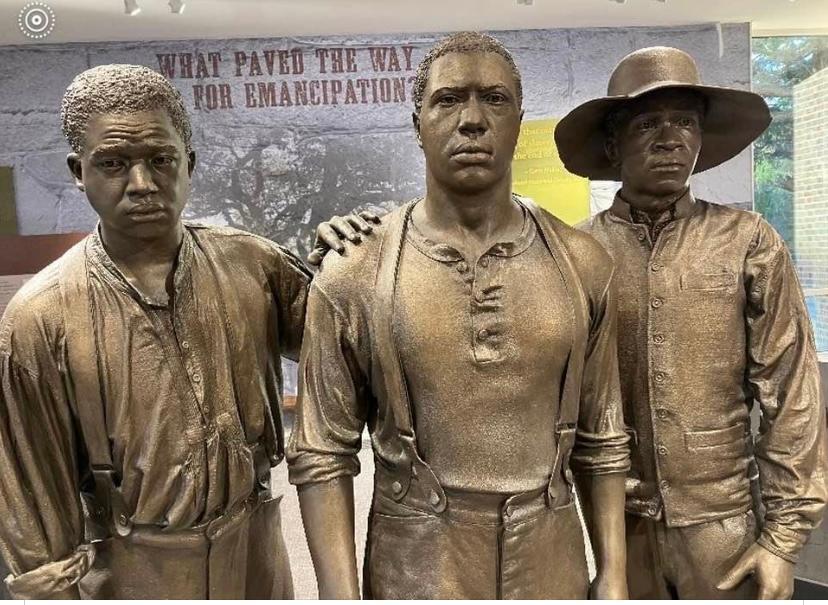The Rock Creek Civil War Roundtable, based in the nation’s capital, has taken on the mission of exploring and revealing the great treasure trove of Black historical facts and figures that are usually ignored or given short shrift by most media and discussion groups vis-a-vis the Civil War.
Black Union soldiers in the Civil War came close to going into battle against Black troops deployed by France and England on the Texas border during the last two years of the Civil War. And the key that opened the door to Black freedom was the self-emancipation of three Black men at Fort Monroe, Va. in 1861, at the beginning of the Civil War and not at its end.
Such unfamiliar gems as these are regularly presented at the monthly gatherings of the Rock Creek Civil War Roundtable that was founded in Washington in 2011 and has been going strong ever since.
“There’s a long history of involvement between the federal government, the Union Army and Navy, and the African American community around Washington, D.C.,” says Roundtable member John Hampton, a federal government retiree.
“That whole area of study is the focus of our presentations,” Hampton said. “And in our 13-14 years of existence, we’ve been all over the place in terms of what we focus on. We’ve done medicine in the Civil War. We’ve done Clara Barton. We’ve had presentations by Edward Ayers of the University of Richmond and the former president of the Organization of American Historians. Ayers founded the New American History movement that advocated for the teaching of history at all grade levels.
“You name it, we’ve done it, from all sides and angles, military-civilian, male-female. We’ve focused on the Civil War technology, on codes and cryptology, and various battles because many of the most important battles took place in this region, in the DC area.
“I’ve always been one who wanted to go back to the foundation of things and figure out where things began,” he said.
The Rock Creek Roundtable is an affiliate of the National Park Service’s public programs effort. Members of the Park Ranger service also participate in the roundtable discussions.
Bennie McRae, one of the first researchers who brought the long-suppressed history of Black people’s crucial involvement in the Civil War within the grasp of the entire nation, was instrumental in setting up the three-way interview Monday with the Jackson Advocate, John Hampton, and himself.
MCRAE TOPIC
McRae is presenting a four-part thesis to the Roundtable on the topic of “the Transition from Slavery to Freedom in the United States: From the 13 Colonies to the 13th Amendment.”
He shines a bright light on the actions of three men – Frank Baker, Shepard Mallory, and James Townsend – who were field hands impressed into building Confederate artillery emplacements by their master, Charles Mallory.
“The escape of Baker, Townsend, and Mallory to Fort Monroe set in motion a chain of dominoes that changed federal policy all over the country. And there are people who don’t want that discussed,” McRae said.
McRae emphasizes that enslaved Black men and women knew from the earliest days of the Civil War that the struggle was about them and their future as a free people.
“Freedom started in May of 1861 when Gen. Butler refused to return those three men to the Confederacy,” he says. “That was the beginning of freedom for slaves in the United States. And that led to other legislation, executive orders, and military action. Then you had the adoption of the opinion that once enslaved people freed themselves they would be free forever. They were fighting their enslavers. And they fought like hell at Milliken’s Bend in June of 1863 and in many other places.”
MEXICAN EMPEROR
Hampton said that France and the newly installed Emperor Maximilian of Austria on the Cactus Throne of Mexico spurred the U.S. into action regarding the deployment of Black troops.
“In 1862, Napoleon III of France sent an occupation force to Mexico,” said Hampton. “Not only that, but he was also sending supplies of weapons to the Confederates. The reason why it took the war so long to end in western Texas was because rebel units were getting resupplied by the French.
“The Confederates didn’t intend to stop in their effort to secede from the United States. They wanted to capture all of Central and South America, all of the Caribbean and recapture Haiti and set up the biggest slave empire anybody ever heard of. And the French were marching in lockstep with them.”
Napoleon III’s French and Austrian forces were defeated by the supporters of Mexican President Benito Juarez at the Battle of Puebla on May 5, 1862, giving rise to the holiday known today as Cinco de Mayo. The French emperor eventually abandoned his cousin Maximilian’s claim to the Mexican throne and withdrew his forces. Maximilian was captured by Juarez and was executed by Juarez on June 19 (Juneteenth) 1867. The Confederate dream of a revived Confederate nation south of the border also died with Maximilian’s death.
McRae noted that there were 16,000 Black troops in the XXV Corps. The focus on the so-called Juneteenth holiday in many ways misses the elephant in the room, he said.
Altogether there were 80,000 Union troops sent to secure the border and put down the Rebel activity that continued in western Texas.
Starting in late 1864, more than 30 United States Colored Troop regiments were reorganized into the 25th Army Corps and shipped to south Texas for patrol along the Rio Grande.
The operation was “huge,” said McRae. “It wasn’t just about freeing the slaves in Texas.”
BLACK IMPORTS
The apparent use of Black troops by France and England in Mexico had helped to provoke the U.S. to muster in 174 Black regiments beginning in May of 1863.
In January 1863, the U.S. legate to Egypt had notified Washington that “four hundred and fifty Black soldiers, by order of the viceroy of Egypt” were being shipped on board a French steamship bound for Mexico. These Africans troops were being sent to aid Napoleon III in his attempt to subjugate Mexico to the rule of distant cousin the Austrian Duke Maximilian.
“The Africans were in position in Mexico by April 1863,” an American observer reported. “They primarily escorted supply trains from Vera Cruz to points across the forbidding Tierra de Caliente. One French officer described the soldiers as ‘tall Nubians, black as soot, dressed in white uniforms with tarbushes on their wooly skulls.’ An American witness depicted them as ‘superb black giants draped in the folds of their white robes and bearing themselves with proud dignity.’”
A month later, the Bureau of Colored Troops began its enlistment of 179,000 Black soldiers and 29,000 sailors in a total of 174 regiments that would be deployed in all fields of action. During the growing concern over the conflict in Mexico, spreading across the border with the help of the Confederate holdovers in Texas, U.S. General Grant and Phil Sheridan, the commander of the Union forces in the southwest, sent at least 30 Black regiments into Texas along with 60,000 white troops to resist any attempts to seize control of the Texas-Mexican borderland from the United States.
Abolitionist lawyer George H. Earle supported the deployment of Black American troops wholeheartedly. “Our country now calls upon the Colored men to defend the flag. And you are organizing that you may say to foreign States, who would interfere in our affairs, ‘Stand back!’ and to the rebel hordes, ‘Disperse!’”
SOUTHERN VICTORY
Hampton points out that despite the century and a half of post-Civil War existence in the United States, the Southern mystique has been an ever-present ogre looming over the lives of Black Americans.
He cited an article from the New Yorker of May 11, 2019 that proclaimed that the South won the Civil War.
“It refers to the Southern culture that evolved over the years from 1619 to 1865,” Hampton said. “At the end of the war, it appeared that the Southern culture would no longer survive. But that culture turned around, became even more strengthened and spread throughout the country.
“Even as we speak, the U.S. is a Southern culture. This cultural logic of the South permeates our federal policy, state policy, and local policy all over the place. If you get sick, you get punished, if you’re poor, you get punished, if you didn’t finish college and get a PhD, you get punished. If you did finish college and got a PhD and got student loans, you get punished. Very consistent, this cultural logic.”
A fundamental part of that cultural logic is that Black folks are supposed to be markedly different from white folks. And in the South, despite the tenets of Plessy vs. Ferguson, to be different is to be unequal and inferior.
The Rock Creek Civil War Roundtable convenes once a month, 11 months a year. For further information and participation in the conversation, contact Bruce Fagin at: azurehome@verizon.net.






